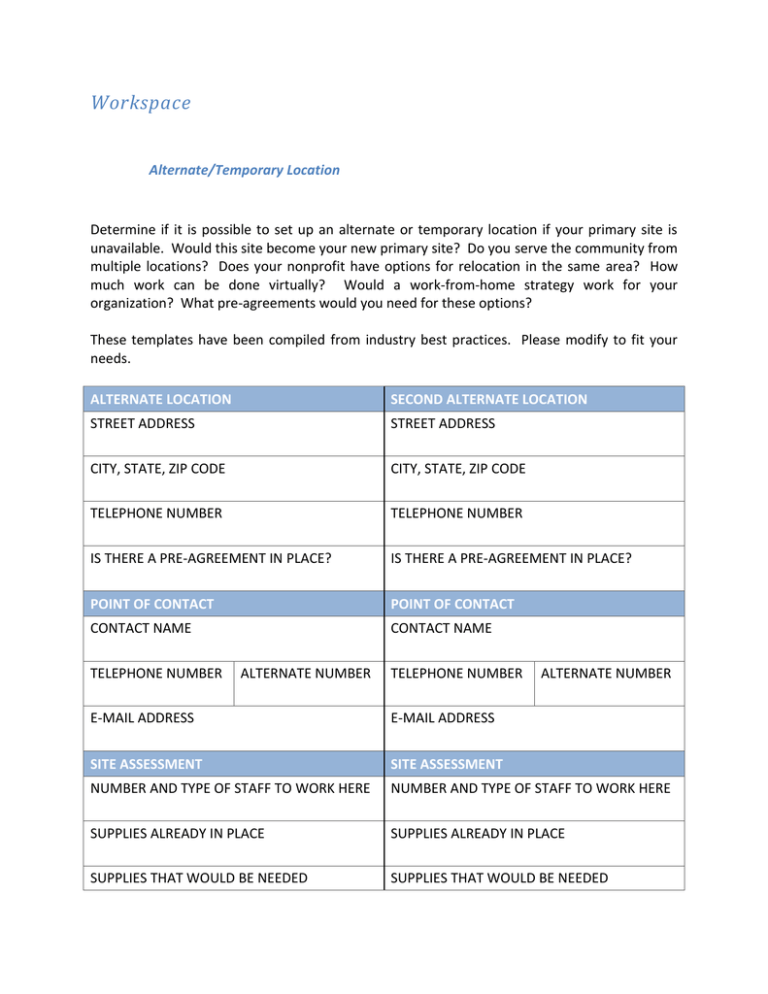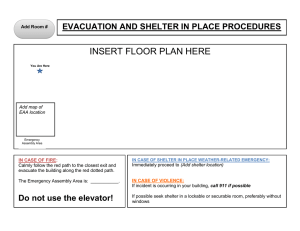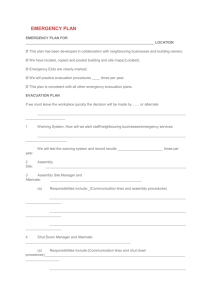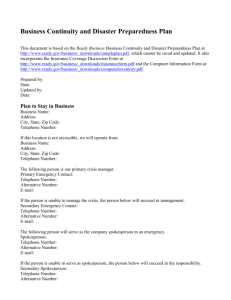Biz Continuity Workspace
advertisement

Workspace Alternate/Temporary Location Determine if it is possible to set up an alternate or temporary location if your primary site is unavailable. Would this site become your new primary site? Do you serve the community from multiple locations? Does your nonprofit have options for relocation in the same area? How much work can be done virtually? Would a work-from-home strategy work for your organization? What pre-agreements would you need for these options? These templates have been compiled from industry best practices. Please modify to fit your needs. ALTERNATE LOCATION SECOND ALTERNATE LOCATION STREET ADDRESS STREET ADDRESS CITY, STATE, ZIP CODE CITY, STATE, ZIP CODE TELEPHONE NUMBER TELEPHONE NUMBER IS THERE A PRE-AGREEMENT IN PLACE? IS THERE A PRE-AGREEMENT IN PLACE? POINT OF CONTACT POINT OF CONTACT CONTACT NAME CONTACT NAME TELEPHONE NUMBER ALTERNATE NUMBER TELEPHONE NUMBER ALTERNATE NUMBER E-MAIL ADDRESS E-MAIL ADDRESS SITE ASSESSMENT SITE ASSESSMENT NUMBER AND TYPE OF STAFF TO WORK HERE NUMBER AND TYPE OF STAFF TO WORK HERE SUPPLIES ALREADY IN PLACE SUPPLIES ALREADY IN PLACE SUPPLIES THAT WOULD BE NEEDED SUPPLIES THAT WOULD BE NEEDED TIME TO SET UP OPERATIONS TIME TO SET UP OPERATIONS LENGTH OF TIME YOU CAN STAY AT THIS SITE LENGTH OF TIME YOU CAN STAY AT THIS SITE POSSIBLE HAZARDS IN THE AREA POSSIBLE HAZARDS IN THE AREA NOTES: NOTES: Insurance Coverage Discussion Form Use this form to discuss your insurance coverage with your agent. Having adequate coverage now will help you recover more rapidly from a catastrophe. INSURANCE AGENT: STREET ADDRESS CONTACT NAME CITY, STATE, ZIP CODE CONTACT TELEPHONE NUMBER TELEPHONE NUMBER FAX NUMBER CONTACT EMERGENCY TELEPHONE EMERGENCY TELEPHONE WEBSITE CONTACT EMAIL INSURANCE POLICY INFORMATION TYPE OF INSURANCE POLICY NUMBER DEDUCTIBLES POLICY LIMITS COVERAGE (GENERAL DESCRIPTION) DISASTER RELATED INSURANCE QUESTIONS Do you need Flood Insurance? □ Yes □ No What perils or causes of loss does my policy cover? Do you need Earthquake Insurance? □ Yes □ No How will my property be valued? Do you need Business Income and Extra Expense Insurance? □ Yes □ No Does my policy cover the cost of required upgrades to code? □ Yes □ No How much insurance am I required to carry to avoid becoming a co-insurer? What does my policy require me to do in the event of a loss? What types of records and documentation will my insurance company want to see? Am I covered for lost income in the event of service interruption because of a loss? Do I have enough coverage? For how long is coverage provided? How long is my coverage for lost income if my facility is closed by order of a civil authority? How will my emergency management program affect my rates? To what extent am I covered for loss due to interruption of power? Is coverage provided for both on- and off-premises power interruption? To what extent am I covered for reduced income due to clients/constituents not all immediately coming back once the facility reopens? Do I have vital document coverage? NOTES Agency Emergency Plan Note the location of your agency emergency plan and other response plans (including fire drill) that your organization has already developed. Where is the plan(s) located? ______________________________________________ How frequently are they updated? _________________________________________ Have your staff and clients been trained on the plans? ___________________________ FACILITY PREPARATION INDICATE THE LOCATION OF THE FOLLOWING ITEMS: Wrenches and other tools Clearly mark your gas and water shut-off valves. Post legible step-by-step directions (in multiple languages if necessary) Keep a conveniently located set of tools to facilitate prompt gas shut off. Tools should include pipe and crescent wrenches Fire extinguisher Emergency first aid supplies Portable radio (AM/FM or Weather radio) and extra batteries Flashlight and extra batteries Garbage bags and duct tape In the case where you would need to shelter-in-place, you will need food and water. What else will be needed depending on your clients? Item: Location: PREPARING STAFF FOR EMERGENCIES In an emergency, the first concern of staff will be the safety and welfare of their family members. Check if completed. Have all staff and key volunteers trained in basic emergency preparedness for the organization. Your agency will want to ensure that all staff members have an opportunity to check on their homes and family members as soon as possible following a disaster. Encourage staff and key volunteers to have a family or home emergency plan. This increases the likelihood that staff and their families can cope with the disaster without outside help. MEETING THE NEEDS OF THE PEOPLE YOU SERVE How many clients would likely be at your site in a disaster (day, evening, weekend?) How would you find out about the condition of people you serve off-site? In an emergency, who else needs information about the status of people that you serve? (off-site staff, families of clients, etc.) List critical contacts: BUILDING EVACUATION (FIRE, etc.) Alarm sounded, 9-1-1 notified Are there program participants who will need assistance evacuating your facility? Remember to assign staff and volunteers to help these participants and have assistive aids/devises available to help with their evacuation. If your facility must be evacuated, assign a staff person the responsibility of taking a head count to ensure all staff, volunteers and program participants have exited. Name: Create an "agency go-kit". Include copies of your emergency plan, action checklists, phone rosters, copies of vital documents, credit cards, etc. Practice your evacuation plan. The following suggestions anticipate that you must evacuate your building and that you are responsible for the care and shelter of the people you serve. Locate and secure a temporary shelter to be used (consider churches, nearby community centers, schools, other residential facilities). You may want to develop mutual aid agreements with these sites. Temporary shelter name: Address: Contact name: Phone: Create a phone list and a system for letting the authorities, family and friends know where you are sheltering your program participants. Designate and identify alternative transportation for moving your program participants to your temporary shelter, or to clients’ homes, if necessary. Alternative transportation: Contact name: Phone: Assign responsibility for the care of your clients at the alternate site(s). Identify this person or persons. If evacuated, what will your clients need that may not be available in the temporary shelter? CONSIDERATIONS FOR PROTECTIVE ACTION (SHELTER-IN-PLACE) Evacuation may not be the best decision. Sudden occurrences (explosions, tornadoes, violent storms/weather conditions, hazardous materials events, etc.) may make sheltering-in-place the best choice. Information gathered from County/Local EMA & Emergency Services about the emergency. Considerations: Is there time to evacuate? Is it safe outside? Is there time to send the staff and clients home? Are the staff and clients’ homes in a danger area? Can the staff and clients be safe inside the building? How long will this event last? Ensure that designated shelter areas are ready to receive and shelter staff and clients. Take attendance to establish accountability for all staff and clients. Remain in place and await further instructions from designated staff person. Depending on the type of hazard: Close windows, blinds, drapes & doors to impede debris from becoming missiles. Close air intakes for HVAC. Reduce all other sources of external air. Other parties notified. Provide meals to sheltered staff and clients if the duration of the emergency warrants. "All-Safe" signal sounded. Who has the authority to give? (What will the signal be? ______________________________________) Other parties notified that the situation is back to normal. BUILDING INTRUDER/SUSPICIOUS ACTIVITY Time is essential here. Everyone must immediately take action. Any staff member who is aware of a potentially dangerous intruder should sound the alarm. 9-1-1 notified. Intruder Alarm given to all concerned parties (via loudspeaker or other method.) All interior and exterior doors locked and windows closed. Staff and clients moved to shelter in the facility. List the room where they will be sheltered: Other parties notified. Building searched by police to find intruder. Other parties notified that the situation is back to normal.




